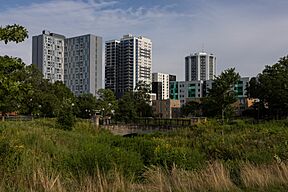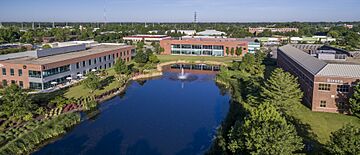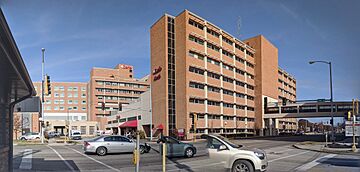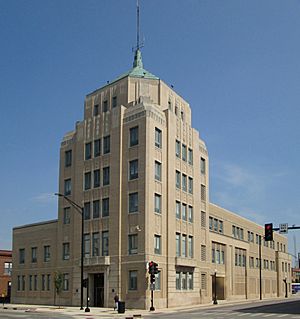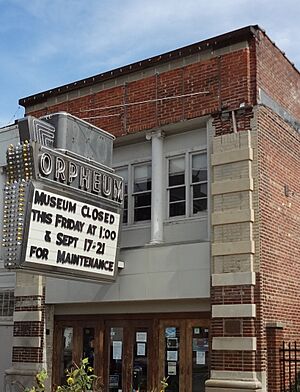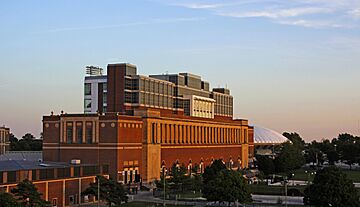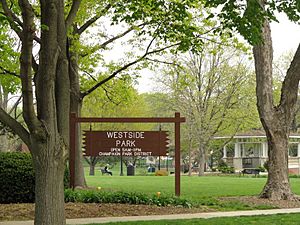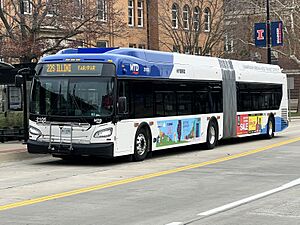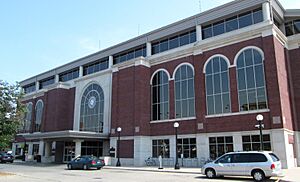Champaign, Illinois facts for kids
Quick facts for kids
Champaign, Illinois
|
||
|---|---|---|
|
|
||
|
||
| Country | United States | |
| State | Illinois | |
| County | Champaign | |
| Founded | 1855 (West Urbana) | |
| Incorporated | 1860 | |
| Chartered | 1866 | |
| Named for | Champaign County, Ohio, U.S. | |
| Government | ||
| • Type | Council–manager | |
| Area | ||
| • City | 23.14 sq mi (59.9 km2) | |
| • Land | 22.99 sq mi (59.5 km2) | |
| • Water | 0.15 sq mi (0.4 km2) | |
| Elevation | 764 ft (233 m) | |
| Population
(2020)
|
||
| • City | 88,302 | |
| • Estimate
(2022)
|
89,241 | |
| • Density | 3,840.89/sq mi (1,482.98/km2) | |
| • Urban | 145,361 | |
| • Metro | 236,072 | |
| Demonym(s) | Champaignian | |
| Time zone | UTC−6 (CST) | |
| • Summer (DST) | UTC−5 (CDT) | |
| ZIP Codes |
61820–61822, 61824–61826
|
|
| Area codes | 217, 447 | |
| FIPS code | 17-12385 | |
| GNIS feature ID | 2393796 | |
Champaign (pronounced sham-PAYN) is a city in Champaign County, Illinois, United States. It's home to over 88,000 people, making it one of the largest cities in Illinois outside of the Chicago metropolitan area.
Champaign is known for being a college town. It shares the main campus of the University of Illinois with its neighbor, Urbana. It also has Parkland College. Because of these schools and many new technology companies, Champaign is sometimes called a "Silicon Prairie" hub. Many big companies like Abbott, Caterpillar, and IBM have offices here. It's also where the popular sandwich chain Jimmy John's started!
Contents
History of Champaign
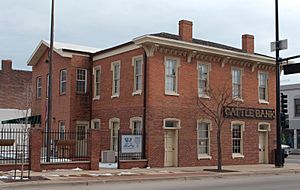
Champaign was founded in 1855. It started when the Illinois Central Railroad built its tracks about two miles west of downtown Urbana. At first, it was called "West Urbana." But in 1860, it became a city and was renamed Champaign. The city and county both got their names from Champaign County, Ohio. That county's name came from a French word meaning "open, level country."
In 1969, musician Carl Perkins and Bob Dylan wrote a song called "Champaign, Illinois." Another band, Old 97's, later made their own popular song with the same name, using a Bob Dylan melody.
A very important event happened in Champaign on September 22, 1985. The first-ever Farm Aid concert was held at the University of Illinois' Memorial Stadium. About 80,000 people came, and the concert raised over $7 million to help American family farmers.
Champaign has also hosted the National Science Olympiad Tournament several times, bringing young scientists from all over the country to the University of Illinois Urbana-Champaign. The city also hosts the state Science Olympiad competition every year.
The city has had two female mayors. Joan Severns was the first, serving from 1979 to 1983. Deb Frank Feinen became the second female mayor in 2015. In 2017, the city council had a majority of women for the first time.
Geography and Climate
Where is Champaign Located?
Champaign is in central Illinois. It sits on higher ground, which helps feed rivers like the Kaskaskia River and the Embarras River. A small stream called Boneyard Creek runs through downtown Champaign.
Champaign shares a border with Urbana. Together, they are often called the "Twin Cities" or "Chambana." The nearby village of Savoy is also part of this area.
Champaign's Weather
Champaign has a humid continental climate. This means it has hot summers and cold, snowy winters. Temperatures often go above 90°F (32.2°C) about 24 days a year. They usually drop below 0°F (−17.8°C) about six nights each year. The hottest temperature ever recorded was 109°F (42.8°C) in 1954. The coldest was −25°F (−31.7°C), which happened four times!
| Climate data for Champaign 3S, Illinois (1991–2020 normals, extremes 1888–present) | |||||||||||||
|---|---|---|---|---|---|---|---|---|---|---|---|---|---|
| Month | Jan | Feb | Mar | Apr | May | Jun | Jul | Aug | Sep | Oct | Nov | Dec | Year |
| Record high °F (°C) | 70 (21) |
72 (22) |
85 (29) |
95 (35) |
97 (36) |
103 (39) |
109 (43) |
102 (39) |
102 (39) |
93 (34) |
80 (27) |
71 (22) |
109 (43) |
| Mean daily maximum °F (°C) | 33.5 (0.8) |
38.4 (3.6) |
50.4 (10.2) |
63.1 (17.3) |
73.8 (23.2) |
82.7 (28.2) |
85.2 (29.6) |
84.0 (28.9) |
78.8 (26.0) |
65.8 (18.8) |
50.7 (10.4) |
38.5 (3.6) |
62.1 (16.7) |
| Daily mean °F (°C) | 25.7 (−3.5) |
29.8 (−1.2) |
40.8 (4.9) |
52.4 (11.3) |
63.2 (17.3) |
72.4 (22.4) |
75.2 (24.0) |
73.8 (23.2) |
67.2 (19.6) |
54.8 (12.7) |
41.4 (5.2) |
31.1 (−0.5) |
52.3 (11.3) |
| Mean daily minimum °F (°C) | 17.9 (−7.8) |
21.2 (−6.0) |
31.2 (−0.4) |
41.6 (5.3) |
52.7 (11.5) |
62.1 (16.7) |
65.2 (18.4) |
63.6 (17.6) |
55.6 (13.1) |
43.9 (6.6) |
32.2 (0.1) |
23.6 (−4.7) |
42.6 (5.9) |
| Record low °F (°C) | −25 (−32) |
−25 (−32) |
−9 (−23) |
14 (−10) |
26 (−3) |
34 (1) |
41 (5) |
37 (3) |
24 (−4) |
12 (−11) |
−5 (−21) |
−20 (−29) |
−25 (−32) |
| Average precipitation inches (mm) | 2.31 (59) |
2.18 (55) |
2.77 (70) |
3.94 (100) |
4.78 (121) |
4.58 (116) |
4.49 (114) |
3.54 (90) |
3.37 (86) |
3.35 (85) |
3.21 (82) |
2.40 (61) |
40.92 (1,039) |
| Average snowfall inches (cm) | 6.5 (17) |
5.8 (15) |
2.5 (6.4) |
0.3 (0.76) |
0.0 (0.0) |
0.0 (0.0) |
0.0 (0.0) |
0.0 (0.0) |
0.0 (0.0) |
0.0 (0.0) |
0.9 (2.3) |
4.8 (12) |
20.8 (53) |
| Average precipitation days (≥ 0.01 in) | 9.9 | 9.2 | 10.8 | 11.9 | 13.4 | 11.2 | 10.3 | 9.1 | 7.9 | 9.8 | 9.8 | 9.9 | 123.2 |
| Average snowy days (≥ 0.1 in) | 5.4 | 4.4 | 2.1 | 0.3 | 0.0 | 0.0 | 0.0 | 0.0 | 0.0 | 0.0 | 1.1 | 4.1 | 17.4 |
| Source: NOAA | |||||||||||||
Economy and Jobs
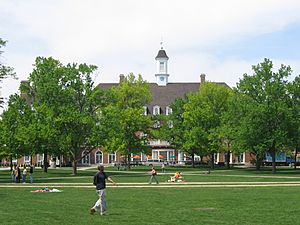
Champaign has a strong economy, especially in technology and research. The University of Illinois Urbana-Champaign is the biggest employer. Kraft Heinz has one of North America's largest pasta factories here.
The area is also known for new startup companies. In 2011, The Christian Science Monitor said Champaign-Urbana was one of the top five cities leading the country's economic recovery. This was because of new jobs in the information sector.
Research Park at the University of Illinois
Champaign has a large technology industry. Many companies focus on creating new technologies. The Research Park is a special area on the university campus. It's home to big companies like Caterpillar, John Deere, IBM, and Yahoo!.
The EnterpriseWorks incubator at Research Park helps new companies get started. Since 2014, it has helped launch over 350 startups. Some of these companies have grown very big, like Agrible and Starfire.
Major Employers in Champaign
Here are some of the biggest employers in Champaign:
| # | Employer | # of Employees |
|---|---|---|
| 1 | University of Illinois Urbana-Champaign | 13,934 |
| 2 | Carle Foundation Hospital | 6,921 |
| 3 | Champaign Unit 4 School District | 1,664 |
| 4 | Kraft Heinz | 925 |
| 5 | Christie Clinic | 916 |
| 6 | Champaign County | 893 |
| 7 | Urbana School District#116 | 828 |
| 8 | FedEx | 815 |
| 9 | OSF HealthCare | 774 |
| 10 | Parkland College | 741 |
Other important employers include Jimmy John's and Wolfram Research. The United States Army Corps of Engineers also has a research lab here.
Arts and Culture
Cool Places to Visit
Downtown Champaign
Downtown Champaign has been growing and changing. It has new buildings with shops and apartments. The Champaign City Building is a well-known landmark. It's where the city government works.
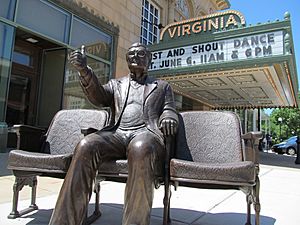
The historic Virginia Theatre is a beautiful old movie theater that opened in 1921. It has a fancy design and a huge screen. It hosts special movie showings and live performances. It's also home to Ebertfest, a film festival.
Campustown
Campustown is a busy area along Green Street. It's a popular spot for students from the University of Illinois and other people in the area. It has many shops and places for entertainment. This area has seen a lot of new construction, with tall apartment buildings and new stores.
Museums and Libraries
- Orpheum Children's Science Museum: A fun, hands-on science museum for kids.
- Krannert Art Museum: An art museum at the University of Illinois Urbana-Champaign. It has a large collection of art from ancient times to today.
- Champaign County Historical Museum: This museum is in the old Cattle Bank building, built in 1858. It shows what life was like in the area long ago.
- Champaign Public Library
- Urbana Free Library
Sports in Champaign
University of Illinois Fighting Illini
The University of Illinois Urbana-Champaign has many sports teams, known as the Fighting Illini. They play in the Big Ten Conference.
| Team | Established | Big Ten Conference Titles | NCAA Postseason Appearances | National Titles | Venue | Opened | Capacity |
|---|---|---|---|---|---|---|---|
| Football | 1890 | 15 | 17 | 5 | Memorial Stadium | 1923 | 60,670 |
| Men's basketball | 1905 | 17 | 30 | 1 | State Farm Center | 1963 | 15,500 |
| Women's basketball | 1974 | 1 | 8 | 0 | State Farm Center | 1963 | 15,500 |
| Baseball | 1879 | 29 | 10 | 0 | Illinois Field | 1988 | 3,000 |
| Women's volleyball | 1974 | 4 | 22 | 0 | Huff Hall | 1925 | 4,050 |
| Men's gymnastics | 1898 | 24 | 44 | 10 | Huff Hall | 1925 | 4,050 |
Famous Stadiums
Memorial Stadium was built in the 1920s to honor students and teachers who died in World War I. It's the home field for the Illinois Fighting Illini football team. The Chicago Bears NFL team even played here for one season while their home stadium was being fixed up.
The State Farm Center is where the men's and women's basketball teams play. It also hosts popular musicals and other live shows.
Local Sports Teams
Champaign has also been home to several minor league baseball teams over the years. These teams played in different leagues, like the Illinois–Indiana League and the Illinois–Missouri League. The city also had collegiate summer baseball teams, where college players could play during their summer break.
In 2014, a professional basketball team called the Champaign Swarm started playing at the Dodds Athletic Center.
Parks and Recreation
Champaign has many parks and trails for outdoor fun. There are over 60 parks and 11 trails across the city, covering more than 654 acres.
Education in Champaign
Schools for Kids
The Champaign Unit 4 School District runs the public schools in the city. This includes two high schools: Champaign Central High School and Champaign Centennial High School.
There are also three private high schools. St. Thomas More High School is the largest. Judah Christian School serves students from pre-kindergarten through 12th grade. Academy High is a newer private high school that focuses on student-centered, project-based learning.
Colleges and Universities
Champaign is home to two important colleges:
- University of Illinois Urbana-Champaign: This is a large public research university and the main campus of the University of Illinois system. Over 50,000 students attend each year!
- Parkland College: This is a community college that serves about 9,000 students annually.
Media and News
Champaign has its own local media to keep people informed and entertained.
- The News-Gazette is the daily local newspaper.
- Daily Illini is the campus newspaper for the University of Illinois.
- Buzz Weekly is a weekly magazine about entertainment.
- Prospectus News is Parkland College's student newspaper.
You can also listen to many radio stations and watch local TV channels in Champaign. NOAA Weather Radio station WXJ76 broadcasts weather alerts for the area.
Getting Around Champaign
Major Highways
Champaign is easy to reach by car because several major highways run through or near it. These include I-57, I-72, and I-74. These highways connect Champaign to other cities like Decatur, Illinois and Indianapolis.
|
Interstate Highways |
Public Transportation
The Champaign–Urbana Mass Transit District (MTD) runs the local bus system. It serves Champaign, Urbana, Savoy, and nearby areas. The C-U MTD has been named the best local transit system in the United States twice!
The Illinois Terminal is a central station for travel. You can catch Amtrak trains here, like the City of New Orleans and the Saluki. It's also a hub for local and intercity bus services.
Train and Bus Services
Train lines run through the city, including one that connects to large food processing plants. You can also find intercity bus services like Greyhound Lines and Peoria Charter Coach Company at Illinois Terminal.
Willard Airport
Champaign has its own airport, Willard Airport (CMI). It's run by the University of Illinois Urbana-Champaign. You can catch daily flights to major airports like Chicago O'Hare International Airport from here.
Notable people
See also
 In Spanish: Champaign (Illinois) para niños
In Spanish: Champaign (Illinois) para niños


